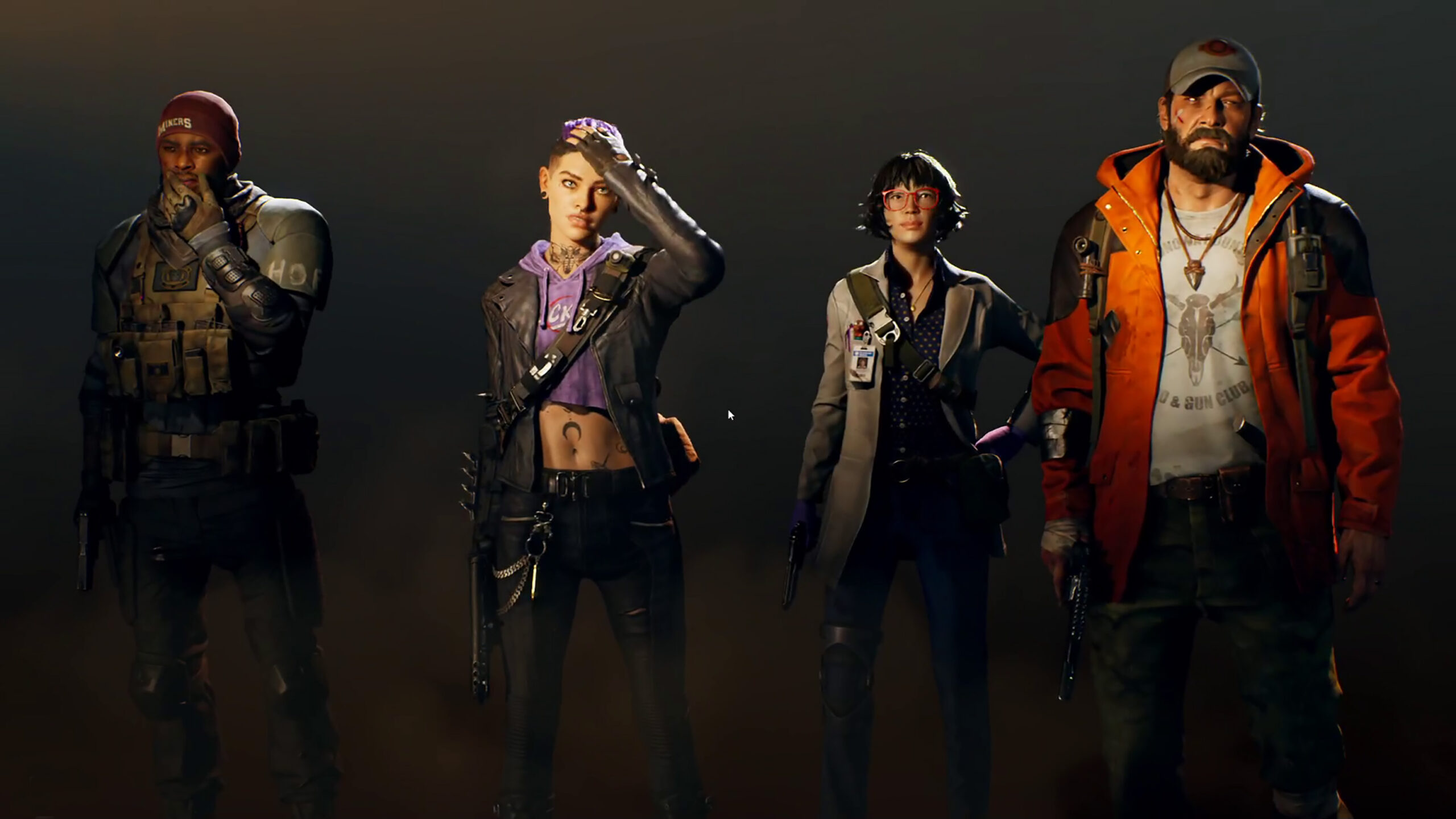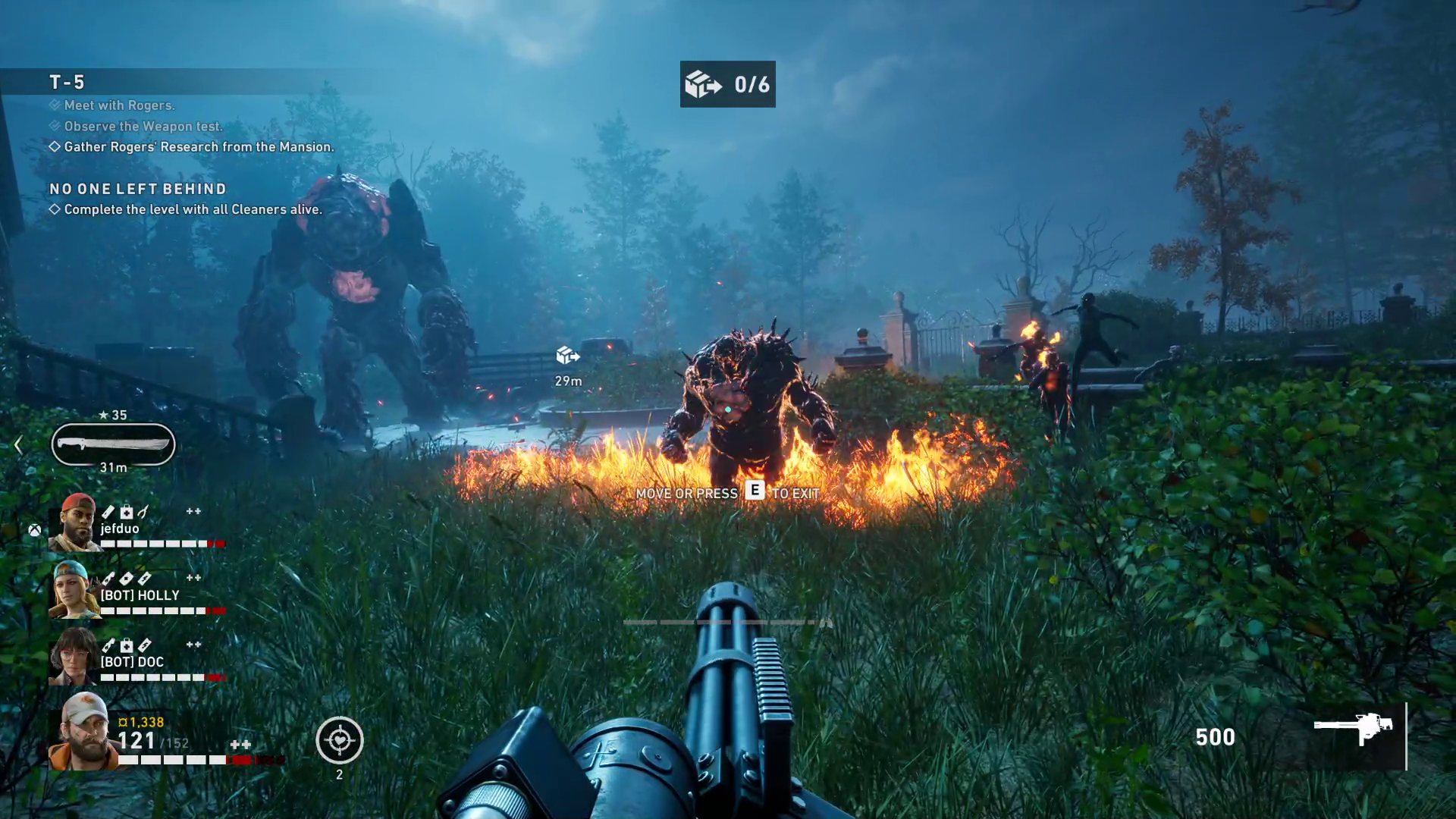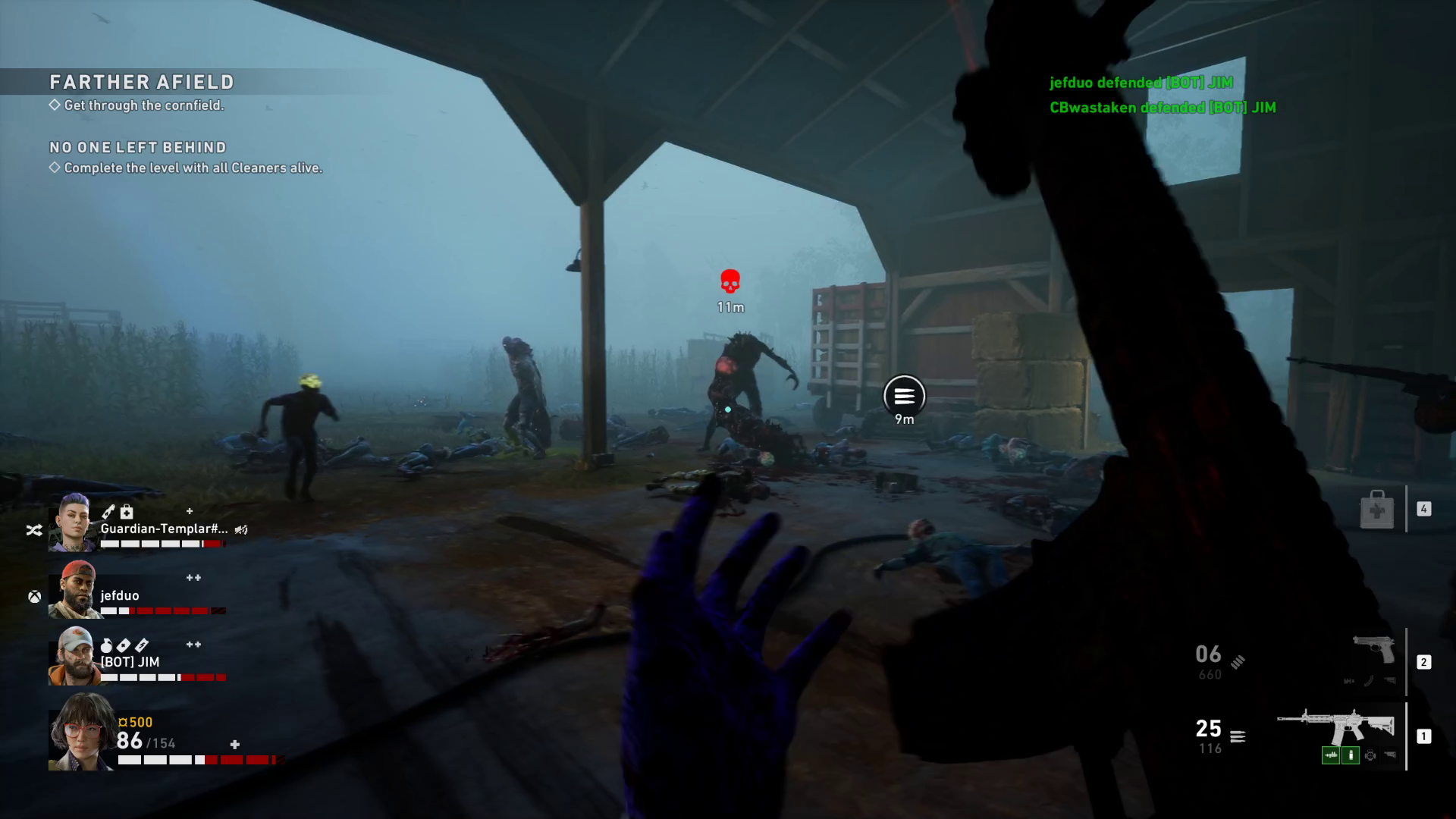
You hear them before you see them. The screams echoing through the trees, as you steel yourself for the fight to come. Dozens of zombies appear on the ridge ahead, descending down the slope at an alarming speed.
Your whole squad opens fire, but the bullets aren’t leaving your gun fast enough to keep up with the number hurtling towards you. A well-timed pipe bomb is lobbed into the horde, distracting the group and taking out enough to thin the herd to a manageable number. You relax a bit, thinking you’re in the clear — until you hear the deep, guttural roar of a Tallboy from the forest and all you can do is run. Welcome to Back 4 Blood.
The latest game from Turtle Rock Studios, Back 4 Blood is now available on PlayStation, Xbox, Game Pass, and PC. The developer best known for creating Left 4 Dead is back with a long-awaited spiritual successor.
For those who aren’t familiar with Left 4 Dead, it was a co-op shooter for up to four players, set in a post-apocalyptic zombie wasteland. You played as a team of survivors trying to escape the hordes through a series of levels that demanded intense coordination and communication from its players.
Does Back 4 Blood manage to recapture the magic of one of the most lauded co-op games of our time?
Almost.
It’s the game you’re expecting. It’s the game you want. But it’s not the game you deserve — yet.
Let’s kill some zomb — Ridden
Back 4 Blood is also a four-player co-op game, only now you’re fighting Ridden instead of zombies. That is to say, there aren’t many major changes to the formula. And no, there isn’t a good justification for why they aren’t called zombies.
Back 4 Blood features a player vs player (PvP) competitive mode called Swarm, but the game is mainly worth playing for its player vs enemy (PvE) campaign.
Played over four acts, the story campaign levels follow a linear format. Players must fend off hordes of Ridden until they reach the next safehouse, gathering loot along the way to upgrade their arsenal. Occasionally you’re tasked with objectives by characters you meet along the way to shake things up, but otherwise, there’s only one goal: survive.

Campaign mode technically has a story, but even after completing all of the acts, the chances of recalling any of it are slim. The Ridden have largely disappeared since the time of the outbreak, but they’ve suddenly made a resurgence. As a Cleaner, it’s your job to eliminate the Ridden, and help secure resources for survivors. Beyond that basic premise, small exchanges between the Cleaners provide a glimpse into their former lives, while radio chatter from non-playable characters handles the heavy lifting in terms of assigning tasks and dropping lore.
For the most part, the writing falls into the realm of campy horror, which is very much in line with the studio’s past games. There are some clever bits of writing, such as a story told by a radio host about how he met his wife, but generally, you’ll likely tune out the dialogue, especially when playing with friends. The worst offender when it comes to the writing is the repetitive dialogue. In a single run of the campaign, you’re bound to hear the same lines time and again. If the audio cues weren’t so important, you could just turn them off. Alas, you’ll get well acquainted with how annoyed your party members are with one another.
Neon brain explosions
While shooting your teammates can be grating for both parties, shooting zombies has never felt better. Not only has the game modernized the shooting controls with ADS, but the weapons feel punchy thanks to some excellent visual and audio design. Landing a headshot results in a satisfying explosion of neon viscera, while hammering foes with melee weapons is accompanied by an impactful thud.

Weapons span the usual automatic, shotgun, and sniper gamut, but there are enough models in each category to find one that suits your style of play. The shotguns pack a punch, the snipers have a nice kick, the LMGs feel weighty, and the SMGs are perfect for spraying crowds. Throw in some melee weapons and offensive items, and you’re set to face the apocalypse. They might not compare to dedicated FPS games such as Battlefield that have been perfecting their shooting year after year, but they’re a drastic improvement from the developer’s previous efforts.
There could be more creativity when it comes to the weapons provided. The included lineup is great, but it feels like the same selection from 2010, just upgraded for 2021.
Fear the Tallboy
And that same problem exists when it comes to the Ridden. They’re a blast to mow down. But they’re hardly unique. There are three main categories of special Ridden: Stingers, Reekers, and Tallboys.
They’re essentially variations on the Infected from Left 4 Dead. Stingers are similar to Hunters and Smokers, preferring to attack from a range before pinning players down. Reekers are similar to Boomers, getting as close as possible before sharing their zombie-attracting mucus with you, or just exploding in your face. And Tallboys are a twist on the Tank, using their oversized arms to wallop you until you’re incapacitated.

Each of these has sub-species that provide a unique twist to keep the challenge fresh, but the lack of variety becomes apparent early in the campaign. Even the bosses that appear every few levels are usually part of a scripted sequence and offer little to experience other than a very large health bar to pick away at.
The special types are far more common than in the studio’s past games. Even on the easiest difficulty, large encounters often have upwards of five special-type Ridden, and it’s rare to go more than a couple of minutes without facing at least one Tallboy or Reeker.
Whether this is a bug with “the director” — the AI working in the background that decides when and how many zombies are sent your way — or an adjustment by the developers, it’s one that has significantly changed the experience while playing. And not for the better.
Difficulty settings are… difficult
It wouldn’t be such a big issue if it wasn’t for the drastic difficulty spikes and enormous gaps between the difficulty settings.
The jump between Recruit to Veteran wasn’t just drastic, it was a slap to the face.
To clarify, a change in difficulty should be a slap in the face. But the respectful kind. The type of slap that wakes you up, forces you to focus, and demands that your play improve or you won’t be able to survive. This wasn’t that. This was a slap that was heard around the world. The type that leaves you lying on the floor questioning whether you’ve ever played a first-person shooter before. Some hyperbole may be present in this part, but the sentiment remains true.

The developers have already said they’ll be addressing the difficulty in an upcoming patch, but until then, Recruit is a good starting point, even for experienced players.
Even on Recruit though, you’ll face a fair challenge at times. The campaign starts out without requiring much thought. Before long the difficulty ramps up, demanding careful coordination from your squad.
Bottom of the barrel bots
It’s a good thing that the bots are up to the challenge when you do. No, wait. That’s not right.
Bots make the game infinitely more challenging. That’s better.
The AI companions in Back 4 Blood are some of the worst in recent memory. Whether they’re standing over your downed body refusing to revive you, teleporting right into your line of fire, or getting caught on the environment, playing with bots is a frustrating experience.
Bots are unable to complete any quest objectives, so if you’re tasked with finding and transporting three briefcases that are scattered across a level, you’ll need to do all of the heavy lifting. Literally. If playing solo, there will be times where you’ll spend large chunks of time just carrying items across the map. The game clearly wasn’t designed with solo mode in mind.
If you need a teammate that will help you through the levels, don’t rely on bots. If you need a teammate that’s an immersion-breaking difficulty multiplier, bots have you covered.

But with a full group of players, that issue isn’t there, and the game clicks. Really clicks.
Just as with the best co-op experiences, Back 4 Blood has enough downtime while collecting items and taking out basic zombies to chat about non-gaming topics, but demands careful coordination and communication when blood hits the fan. There are moments when chaos reigns, with bullets spraying, guitar riffs screaming out, and zombies exploding over just before they reach you. And they’re glorious.
The minute-to-minute gameplay experience is a balance between looking for shooting zombies, avoiding traps, and collecting cards.
The hand you’re dealt
One of the major additions to progression is the card system. Don’t worry though, this isn’t another Slay the Spire clone.
The card system is a clever way to add replayability to the campaign by randomizing the upgrades available on any given run. Cards can be unlocked by gaining experience, or found hidden throughout levels of the campaign.
At the beginning of the game, you’ll have a deck of just six cards, each with an upgrade. These early cards feature upgrades such as +20 percent accuracy or +5 health. But as you play, you’ll unlock more cards that will allow you to tailor your skills to your playstyle. If players want to play a melee-focused character, selecting a Cleaner such as Holly who gains stamina with every melee kill, and then taking cards that give health and extra damage for melee kills can create a very effective build. Whether your team needs a healer, tank, damage dealer, or if you just want to be a pyromaniac, you can build your deck to support that.

Each run feels different thanks to your deck and the corruption cards. Each level begins with drawing corruption cards that will randomly introduce a challenge. These range from adding special Ridden, to adding a heavy fog that severely limits visibility.
The cards are a great addition, but they don’t go nearly far enough. Aside from the fog, almost all of the corruption cards are just special Ridden. The player card bonuses don’t make your player feel drastically different to play. By the end of a run, you can have a very powerful Cleaner, but unlike the games that most effectively use this type of randomized upgrade system, you often don’t feel that power translate to the gameplay.
It would be great to see the developers continue to add cards with new abilities, or add more cards that penalize the player for more drastic upgrades. There are a few of these in the deck, but they often are just a trade between stamina and health, or accuracy.
Call in the Cleaners
Each Cleaner has unique abilities, adding an extra level of depth. Choosing a well-rounded group of characters is essential for surviving.
The Cleaners don’t have much depth to them, but aside from a couple of characters who would be better off being fed to the undead, they’re a likeable bunch. With a full party of four running the campaign, making fun of the dialogue is half the fun.
And at the end of the day, that’s where the game succeeds. There are very few games that make teamwork this much fun. The game demands a lot from its players, and it rewards the teams that meet those demands.

Swarm mode
The same can’t be said for Swarm mode. This PvP mode pits Cleaners against player-controlled special Ridden. The teams swap back and forth between the two, seeing who can last the longest as Cleaners before they’re overwhelmed.
Unlike the old PvP campaign mode in Left 4 Dead 2, this mode feels repetitive, placing players in a small arena with a shrinking map like those found in battle royales. The Ridden are fun to play at first, but with only two abilities and only a handful of spots to hide on any map given the layouts, there isn’t enough depth to keep players engaged. Matches regularly see players drop out on the losing side, leaving the winning team playing against normal Ridden zombies for the rest of the match, dragging out what’s an inevitable victory for an excruciating amount of wasted time. Turtle Rock will have to find a way to discourage players from dropping out of matches, or this mode will likely be dead on arrival — as opposed to undead on arrival.
Swarm mode doesn’t hurt the overall package, but it feels like an afterthought as opposed to something the team put in the game because they felt passionate about the idea. There’s a chance that the developers will add a PvP campaign down the road, but until then, PvE is the best way to experience the game.
Back 4 the better
What Back 4 Blood lacks in creativity and polish it makes up for with an unparalleled co-operative experience. There still isn’t anything on the market that quite reaches the heights of Left 4 Dead 2, but with time Back 4 Blood may just surpass its spiritual predecessor.
The AI is lacking, the enemy types are recycled from other games, and the difficulty is all over the map, but taken as a whole, the game is worth playing with friends. The card system adds a clever layer of customization and replayability, and if you can make it through the first few levels, you’ll discover some excellent level design with a great atmosphere.
Back 4 Blood brings zombies back 4 the better. It just needs a bit of time to evolve into the game players have waited a decade for.
Image credit: Warner Bros. Interactive Entertainment
MobileSyrup may earn a commission from purchases made via our links, which helps fund the journalism we provide free on our website. These links do not influence our editorial content. Support us here.


